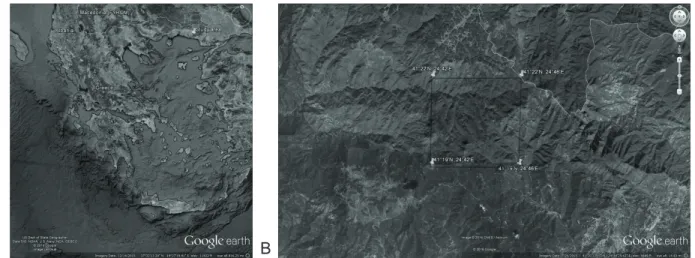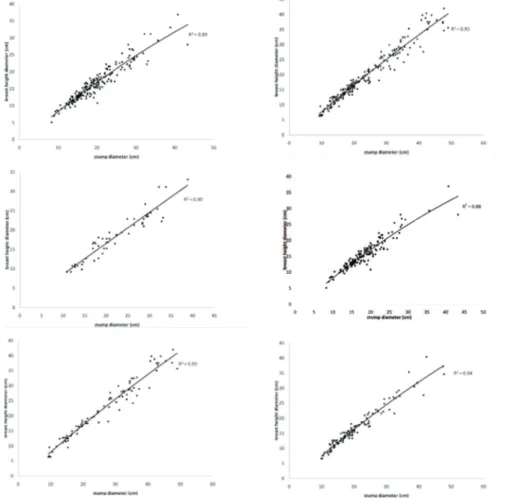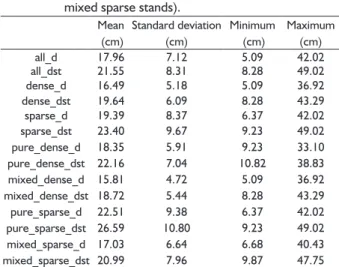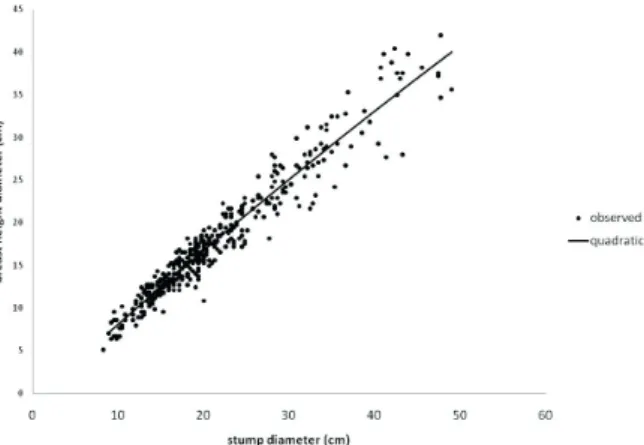Palavras chave: Diâmetro à altura do peito
Diâmetro à altura do toco Estimativa por regressão Histórico: Recebido 25/06/2016
Aceito 13/09/2016 Keywords: Diameter at breast heigh Diameter at stump height Regression estimation
1 Democritus University - Xanthi, Greece Correspondência:
kkitikid@fmenr.duth.gr
DOI: 10.1590/01047760201622032193
Elias Milios1, Kyriaki G Kitikidou1, Vasileios Dalakouras1, Elias Pipinis1
DIAMETER AT BREAST HEIGHT ESTIMATED FROM STUMPS IN QUERCUS
FRAINETTOIN THE REGION OF EVROS IN NORTHEASTERN GREECE
ABSTRACT: For foresters, it is sometimes required to estimate the diameter at breast height of tree that has been cut, though it is often only the stump that is available as an indicator of size, after illegal logging and quick removal of the cut trees from the forest. In this study, equations for predicting the diameter at breast height, were fi t specifi cally for Quercus frainetto in the region of Evros in northeastern Greece. The selected equations (quadratic model) were, where dˆ is the estimated diameter at breast height d (cm), and dst is the measured diameter at stump height (cm); ˆ 2
0.359 0.869 st 0.001 st
d= − + d − d
for pure stands (R2 = 0.94); ˆ 2
1.571 0.993 st 0.004 st
d= − + d − d for mixed stands (R2 = 0.92); 2
ˆ 0.880 0.915 0.002
st st
d= − + d − d for the whole forest (R2 = 0.94).
DIÂMETRO À ALTURA DO PEITO ESTIMADA A PARTIR DE TOCOS DE QUERCUS FRAINETTO NA REGIÃO DE EVROS NO NORDESTE DA GRÉCIA
RESUMO: Para silvicultores, às vezes é necessário estimar o diâmetro à altura do peito de árvores cortadas, embora muitas vezes é somente o toco que está disponível como um indicador do tamanho, após a extração ilegal de madeira e remoção rápida das árvores cortadas da fl oresta. Neste estudo, equações para estimar o diâmetro à altura do peito foram ajustados especifi camente para Quercus frainetto na região de Evros no nordeste da Grécia. As equações selecionadas (modelo quadrático) foram:
2 ˆ 0, 359 0,869 0, 001
st st
d= − + d − d para talhões puros (R2 = 0.94); ˆ 2
1, 571 0, 993 st 0, 004 st
d= − + d − d
para talhões mistos (R2 = 0.92); ˆ 2
0,880 0, 915 st 0, 002 st
d= − + d − d para a fl oresta toda (R2 =
0.94), onde é o diâmetro estimado na altura do peito (cm), e dst é o diâmetro medido na altura do toco (cm); para povoamentos puros (R2 = 0,94);
FRAINETTO IN THE REGION OF EVROS IN NORTHEASTERN GREECE
INTRODUCTION
The most important variable to take into consideration regarding to forestry is tree diameter at breast height. Not only it is used to estimate the volume of the tree, but also as a way to describe the stand structure and to select an inventory sample. When a tree has been cut down, and the only thing that remains to indicate its former size is the stump, it becomes necessary to use these dimensions to predict the diameter and volume. Examples include (1) when the timber has already been harvested in the final cut or thinned, (2) when checking the harvesting practices after tree removal, (3) determining the loss of volume due to illegal cutting, (4) assessing the damage that results from environmental disturbances, and (5) tracing history of the cutover stands (MCCLURE 1968, BYLIN 1982, KOZAK and OMULE 1982, WHARTON 1984, KHATRY CHHETRI and FOWLER 1996, CORRAL-RIVAS et al. 2007, ÖZÇELÍK et al. 2010).
Current studies estimating diameter at breast height, and trees’ volume from stump dimensions, are based on charts, equations, or tables. (BYLIN 1982, KOZAK and OMULE 1982, MCCLURE 1968, WHARTON 1984, KHATRY CHHETRI and FOWLER 1996, CORRAL-RIVAS et al. 2007, ÖZÇELÍK et al. 2010). Tree volume estimate is done in two steps. Firstly, diameter at breast height is measured; then, tree volume is estimated generally by using a one-entry volume table. However, when one-entry volume tables are unavailable, or cannot be elaborated upon (e.g. often when cutting trees in an isolated area); as such, in order to predict the volume of the trees that have been removed, other methods may be required.
Quercus spp. forests comprise the 22.6 % of the area of all Greek forests (MINISTRY OF AGRICULTURE 1992). One of the most common Quercus species
of the mainland country that dominates in most oak forests is Q. frainetto (BERGMEIER and DIMOPOULOS 2008, KORAKIS, 2015). It expands from the Balkans to central Europe, while it is also found in south Italy and Anatolia (CHRISTENSEN, 1997). It is considered a significant species for timber (CHRISTENSEN, 1997), which forms pure and mixed deciduous forests, while also it is found in open woodlands (BORATYNSKI, et al. 1992; CHRISTENSEN, 1997). Quercus frainetto is usually appears at altitudes between 200 and 1,200 m (BORATYNSKI, et al. 1992; CHRISTENSEN, 1997). However it can be found in lowland degraded forests (MILIOS, et al. 2014, BATZIOU, et al. 2016). It is an intermediate shade tolerant species (Athanasiadis 1986). Even though it has the ability to appear and grow in low productive sites (KITIKIDOU, et al. 2015; KORAKIS, 2015), it exhibits the best growth in fertile sites (KORAKIS , 2015). Moreover, Q. frainetto is considered as a drought tolerant species (ABBATE, et al. 1990; RAFTOYANNIS, et al. 2006)
Current equations estimating diameter at breast height from diameter at stump height developed for Q. frainetto in the south Evros region are presented. These equations can serve as an indicator of size, especially for trees removed from the forest due to illegal logging; in that case, the stump is the only available part left for diameter measurements.
MATERIAL AND METHODS
Study area
The study was carried out in northeastern Greece, in the southern part of the region of Evros (Figure 1). It covers an area of approximately 1,118 ha between the altitudes of 364 and 1,072 m. Mean annual air temperature, according to the data of the closest
A B
of adjacent trees in a great part of its circumference. The trees documented covered an existing range of qualities, and were selected in stands located within the study location. Trees were randomly selected, ensuring that there was a representative distribution among the diameters and height classes. Perimeter p at breast height 1.3 m, d (in cm), and the perimeter at stump height 0.2 m dst (in cm) were measured in each tree, using a measurement tape of 1 cm precision. Diameter was calculated applying the equation 1.
Relationships between diameter at stump height p
d
π
= [1]
meteorological station is 14.8 oC and the total annual
precipitation is 558.9 mm (Study of Protection and Management of the “Notios” forest 2008). The trees used in this study were selected from pure and mixed Q. frainetto stands. The mixed stands involved Q. frainetto, Fagus sylvatica or Quercus pubescens or Q. coccifera.
Data
Equations to predict diameter at breast height from stump diameter were developed using data of 135 trees selected from pure stands, and 250 trees from mixed stands. Eighty four trees (SP trees), growing more or less freely, were selected in sparse pure stands, while 51 trees (DP trees) were selected in dense pure stands of the species. On the other hand, 111 (SM trees) trees, growing more or less freely, were selected in sparse mixed stands, and 139 trees (DM trees) were selected in dense mixed stands. In order for a tree to be classifi ed as a SP or a SM, the closest distance between its crown and the crowns of adjacent trees had to be more than 0.5 m. The rest (being closer to a adjacent tree) were classifi ed as DP and DM trees. However, the crown of almost all selected DP and DM trees touched the crown
and diameter at breast height were examined by visually comparing scatter plots of stump diameter against diameter at breast height (Figure 2). Outliers weren’t present in this study. The summary statistics of these fi nal datasets, used to develop the equations to predict the diameter at breast height from the stumps, as shown in Table 1.
FIGURE 2 Scatter plots breast height diameter - stump height diameter of subsamples (beginning from the upper left corner:
FRAINETTO IN THE REGION OF EVROS IN NORTHEASTERN GREECE
Comparing Models
When judging the performance criteria of the functions, a numerical and graphical base was used to analyze the residuals. The two statistics that were calculated were the root mean square error (RMSE) and the coefficient of determination (R2) (KITIKIDOU, 2005).
The statistical expressions are as follows [2] and [3], where di, dˆiand d are the observed, the predicted
and mean values, respectively, of the dependent variable, and n is depicted as the total number of observations used to fit the model.
(
)
2 1 ˆ n i i i d d RMSE n = −= ∑ [2]
(
)
(
)
2 2 1 2 1 ˆ 1 n i i i n i i i d d R d d = = − = − − ∑ ∑ [3] Models AnalyzedEleven different models were tested, each available in the Curverfit command of SPSS v.21 (IBM 2012), to help develop the equations used for predicting the parameters. Stump diameter was measured at 20 cm height (above ground level), and thus the stump height was not included as a covariate in the models. The models tested are shown in Table 2. Where: estimated diameter at breast height d (cm), bi: regression coefficients, dst: measured diameter at stump height (cm), u: upper boundary value (max d rounded up).
TABLE 1 Statistic summaries for sampled trees, for each
measured variable (breast height diameter d and stump height diameter dst), and subsample (whole forest, dense stands, sparse stands, pure dense stands, mixed dense stands, pure sparse stands, mixed sparse stands).
Mean (cm) Standard deviation (cm) Minimum (cm) Maximum (cm)
all_d 17.96 7.12 5.09 42.02
all_dst 21.55 8.31 8.28 49.02
dense_d 16.49 5.18 5.09 36.92
dense_dst 19.64 6.09 8.28 43.29
sparse_d 19.39 8.37 6.37 42.02
sparse_dst 23.40 9.67 9.23 49.02
pure_dense_d 18.35 5.91 9.23 33.10
pure_dense_dst 22.16 7.04 10.82 38.83
mixed_dense_d 15.81 4.72 5.09 36.92
mixed_dense_dst 18.72 5.44 8.28 43.29
pure_sparse_d 22.51 9.38 6.37 42.02
pure_sparse_dst 26.59 10.80 9.23 49.02
mixed_sparse_d 17.03 6.64 6.68 40.43
mixed_sparse_dst 20.99 7.96 9.87 47.75
TABLE 2 Evaluated mathematical expressions for the models
tested for breast height diameter estimation from stump diameter. 1. Linear 2. Logarithmic 3. Inverse 4. Quadratic 5. Cubic 6. Power 7. Compound 8. S-curve 9. Logistic 10. Growth 11. Exponential ˆ d 1 0
ˆ b dst
d=b e 0 1
ˆ
b b dstd
=
e
+( )
0 11 ˆ
1 dst
d b b u = + 1 0 ˆ st b b d d e + =
( )
0 1ˆ dst
d=b b
( )
10
ˆ b
st
d=b d
2 3
0 1 2 3
ˆ
st st st
d= +b b d +b d +b d
2
0 1 2
ˆ
st st
d= +b b d +b d
1 0 ˆ st b d b d = + 0 1 ˆ ln st
d= +b b d
0 1
ˆ
st
d= +b b d
In order to compare the predictive capabilities of the models, one should take into account that the residuals (the RMSE criterion in our study) and the measurements of quality (the R2 criterion in our study)
do not determine the quality of future prediction (Myers 1990). To this end, the model must be verified for this process, and only a newly collected dataset will be viable in this instance. However, as such data are scarce, several other methods have been proposed, though they seldom provide additional information when compared with the statistics that have been obtained directly from other complete datasets (KOZAK and KOZAK, 2003). Hence, validations can only be performed once new data have been collected and have become available.
RESULTS - DISCUSSION
Model selection
The statistics for each of the different models tested for diameter estimation are shown in Table 3 (all contained significant parameters). Optimal values are highlighted. The quadratic model performed best (Figure 3).
The R2 values of both selected models are high.
However, in the trees which grow in sparse stands (SP, SM trees) the R2 values (0.9500, 0.9426, respectively) of
the selected models are higher than the R2 values of the
according to tree density and social position. Thus, in the present study the trees from the dense stands (DP, DM trees) can exhibit a high variability of form factors. However, this is not the case for the trees from sparse stands (SP, SM trees) which grow freely without intense competition from the adjacent trees. This is the reason for the lower estimation ability (lower R2 values) of the
selected models for DP and DM trees compared to the selected models for SP and SM trees. Furthermore, high variability of form factors infl uences the volume prediction models (KITIKIDOU, et al. 2016).
Nevertheless, in the present study the model selected for all measured trees (Figure 4) had a R2 of
0.94, which is relatively high (Table 4). As a result, it is recommended for general use for simplicity as well as for accuracy reasons. More research is needed in order to be developed analogue models for more species. Moreover, use of competition indices may increase the accuracy of the models, through more accurate stem form predictions, especially when simple models are not accurate.
TABLE 3 Comparison statistics (root mean square error
(RMSE) and coeffi cient of determination R2), for
pure and mixed stands, for the eleven models tested for breast height diameter estimation from stump diameter.
Variables Pure stands Mixed stands
Model RMSE R2 RMSE R2
1 2.00 0.94 1.66 0.91
2 55.68 <0 44.48 <0
3 3.70 0.79 2.76 0.76
4 2.00 0.94 1.63 0.92
5 29.68 <0 224.57 <0
6 12.66 <0 8.79 <0
7 2.01 0.94 1.67 0.91
8 2.65 0.89 2.10 0.86
9 3.03 0.86 2.71 0.77
10 3.04 0.86 2.72 0.77
11 2.14 0.93 1.66 0.91
A
FIGURE 3 Fitting of the quadratic model estimating breast
height diameter from stump diameter - (A) pure
stands (ˆ 2
0.359 0.869 st 0.001 st
d= − + d − d ); (B) mixed
stands (ˆ 2
1.571 0.993 st 0.004 st
d= − + d − d ).
B
TABLE 4 Comparison statistics (root mean square error
(RMSE) and coeffi cient of determination R2), for the eleven models tested for breast height diameter estimation from stump diameter - whole forest (pure and mixed stands).
Model RMSE R2
1 1.03 0.94
2 963.15 <0
3 5.98 0.78
4 0.99 0.94
5 1944.85 <0
6 20.89 <0
7 1.00 0.94
8 1.39 0.88
9 2.13 0.85
10 2.13 0.85
11 1.16 0.93
FIGURE 4 Fitting of the quadratic model estimating breast
height diameter from stump diameter - whole forest ( ).ˆ 0.880 0.915 0.002 2
st st
d= − + d − d
FRAINETTO IN THE REGION OF EVROS IN NORTHEASTERN GREECE
In the models tested, stump height was not considered as covariate, as each of the trees had been measured at the same stump height (20 cm). While prior studies have revealed that, for species having more or less the same stump height, this variable (i.e. stump height) did not significantly improve the variability explained by the regression equations that were developed for predicting diameter at breast height from diameter at stump height (e.g. Bylin 1982), this limitation suggests that further work and data is needed to be evaluated before adapting the equations to test stumps resulting from trees that have been cut at heights different from 20 cm.
CONCLUSION
In this study, equations to predict diameter at breast height from diameter at stump height, were developed. Fittings for pure Quercus frainetto stands, mixed stands, and for the whole forest were tested. These equations are useful for direct calculations of the volume of cut trees. This is particularly interesting for the prediction of the volume of trees that have been illegally cut down. Even if logs have been removed from the forest, one will still be able to obtain their diameter at breast height by employing these models. The selected equations (quadratic model) were: dˆ= −0.359+0.869dst−0.001dst2 for
pure stands (R2 = 0.94) ˆ 2 1.571 0.993 st 0.004 st
d= − + d − d for
mixed stands (R2 = 0.92) ˆ 2 0.880 0.915 st 0.002 st
d= − + d − d for
the whole forest (R2 = 0.94), where ˆ
d is the estimated
diameter at breast height d (cm), and dst is the measured diameter at stump height (cm).
REFERENCES
ABBATE, G., BLASI, C., PAURA, B., SCOPPOLA, A., SPADA, F. 1990. Phytoclimatic characterization of Quercus frainetto Ten. stands in peninsular Italy. Vegetatio 90: 35-45.
ARLINGHAUS, S. 1994. Practical handbook of curve fitting. CRC Press, USA.
ATHANASIADIS, N. 1986. Forest botany, Part II. Giahoudis- Giapoulis, Thessaloniki, Greece [in Greek].
BATZIOU, M., MILIOS, E., KITIKIDOU, K. 2016. Is diameter at the base of the root collar a key characteristic of seedling sprouts in a Quercus pubescens - Quercus frainetto grazed forest in north-eastern Greece? A morphological analysis.
New Forests.
BERGMEIER, E., DIMOPOULOS, P. 2008. Identifying plant communities of thermophilous deciduous forest in Greece: Species composition, distribution, ecology and syntaxonomy. Plant Biosystems 142 (2): 228-254.
BORATYNSKI, A., BROWICZ, K., ZIELINSKI, J. 1992.
Chorology of trees and shrubs in Greece. Kornik, Poznan
BYLIN, C. 1982. Volume prediction from stump diameter and
stump height of selected species in Louisiana. USDA Forest Service, Southern Forest Experiment Station, Research Paper SO-182. 11 pp.
CHRISTENSEN, K. 1997. Fagaceae. In: Flora Hellenica (Strid A, Tan K eds). Koeltz Scientific Books, Germany, pp. 40–50.
CORRAL-RIVAS, J., BARRIO-ANTA, M., AGUIRRE-CALDERON, O., DIEGUEZ-ARANDA, U. 2007. Use of
stump diameter to estimate diameter at breast height and tree volume for major pine species in El Salto, Durango (Mexico). Forestry 80(1): 29-40.
DEMAERSCHALK, J., OMULE, S. 1982. Estimating Breast
Height Diameters from Stump Measurements in British Columbia. The Forestry Chronicle 58(3): 143-145.
FOREST SERVICE OF ALEXANDROUPOLI (GREECE). http:// gdday.damt.gov.gr/index.php/ddd/77-dasarxeio-alexandr
FRITTS, H. 1976. Tree rings and climate. Academic Press Inc London.
IBM Corp. Released 2012. IBM SPSS Statistics for Windows,
Version 21.0. Armonk, NY: IBM Corp.
KHATRY CHHETRI, D., FOWLER, G. 1996. Estimating diameter at breast height and basal diameter of trees
from stump measurements in Nepal’s lower temperate
broad-leaved forests. Forest Ecology And Management
81(1-3): 75-84.
KITIKIDOU, K. 2005. Applied statistics with use of the SPSS statistical package. Tziola publications, Thessaloniki, Greece [in Greek].
KITIKIDOU, K., MILIOS, E., KATSOGRIDAKIS, S. 2016. Meta-analysis for the volume of Pinus sylvestris in Europe.
Revista Chapingo Serie Ciencias Forestales y del
Ambiente. Accepted for publication.
KITIKIDOU, K., MILIOS, E., LIPIRIDIS, I. 2014. Tree volume estimates and nearest neighbor analysis in the stands of scots pine (Pinus sylvestris) in the central part of Rodope mountain. Šumarski list, 138(11-12), 573-582.
KITIKIDOU, K., MILIOS, E., TSIREKIS, E., PIPINIS, E.,
STAMPOULIDIS, A. 2015. Site quality assessment of degraded Quercus frainetto stands in central Greece.
iForest 8: 53-58.
KORAKIS, G. 2015. Forest Botany (e-book). Hellenic Academic
KOZAK, A., KOZAK, R. 2003. Does cross validation provide additional information in the evaluation of regression models?. Canadian Journal of Forest Research
33(6): 976-987.
KOZAK, A., OMULE, S. 1992. Estimating stump volume, stump inside bark diameter and diameter at breast height from stump measurements. The Forestry Chronicle
68(5): 623-627.
MCCLURE, J. 1968. Predicting tree dbh from stump
measurements in the southeast. USDA Forest Service,
South Eastern Forest Experiment Station, Research
Note SE-99. 60 pp.
MILIOS, E., AKRITIDOU, S. 2002. Growth patterns of beech (Fagus sylvatica s.l.) trees under different growth conditions. In: Proceedings of the 10th conference of Hellenic forestry
society, pp 676–684 [in Greek].
MILIOS, E., PIPINIS, E., KITIKIDOU, K., BATZIOU, M.,
CHATZAKIS, S., AKRITIDOU, S. 2014. Are sprouts the dominant form of regeneration in a lowland
Quercus pubescens–Quercus frainetto remnant forest in Northeastern Greece? A regeneration analysis in the
context of grazing. New Forests 45: 165–177.
MINISTRY OF AGRICULTURE. 1992. Results of the first national forest inventory. The final data process was made
by Tsaprounis I., Publication of Department of forest mapping, Athens [in Greek].
MYERS, R. 1990. Classical and modern regression with applications. 2nd edition. Duxbury Press, Boston, USA.
ÖZÇELÍK, R., BROOKS, J., DIAMANTOPOULOU, M., WIANT, H. 2010. Estimating breast height diameter and
volume from stump diameter for three economically important species in Turkey. Scandinavian Journal Of
Forest Research 25(1): 32-45.
PHILIP, M. 1994. Measuring trees and forests. CAB International, UK.
POND, N., FROESE, R. 2014. Evaluating published approaches
for modelling diameter at breast height from stump dimensions. Forestry 87(5): 683-696.
RAFTOYANNIS, Y., RADOGLOU, K., HALIVOPOULOS, G.
2006. Ecophysiology and survival of Acer pseudoplatanus L., Castanea sativa Miller. and Quercus frainetto Ten. seedlings on a reforestation site in northern Greece. New
Forests 31:151-163.
SMITH, D., LARSON, B., KELTY, M., ASHTON, P. MARK,
S. 1997. The practice of silviculture. Applied Forest Ecology. John Willey & Sons, Inc.
STUDY OF PROTECTION AND MANAGEMENT OF THE “NOTIOS” FOREST. 2008. Managing period 2008 - 2017.
Forest Service of Alexandroupolis, Region of Eastern
Macedonia - Thrace, Greece.
WHARTON, E. 1984. Predicting diameter at breast height from stump diameters for the northeastern
tree species. USDA Forest Service, North Eastern Forest
Experiment Station, Research Note NE-322. 4 pp.



